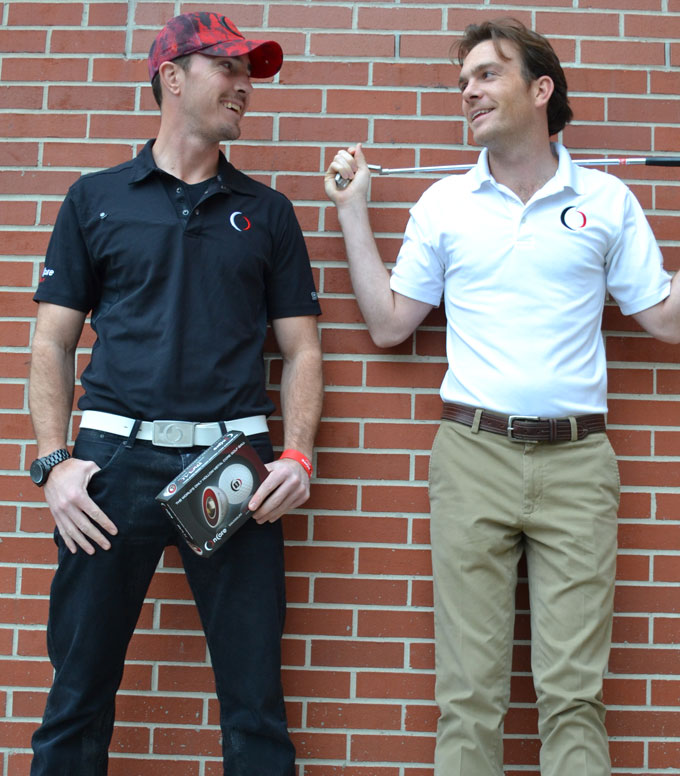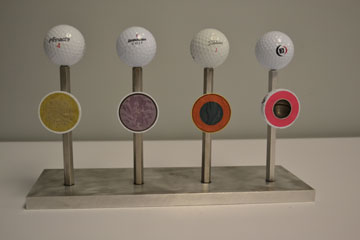Next story: At the halfway point, a look ahead at the Bills season
Buffalo startup OnCore Golf wants to change the game
by Ethan Powers

Keep your eye on the ball
Sitting on a large wooden desk amidst OnCore Golf’s large, spacious office in the heart of the Buffalo Niagara Medical Campus’ Innovation Center is a golf ball. Its exterior is not unlike the countless ones you’ve driven into the oblivion of your local course. What’s on the inside however, could be the very key to the sport’s next big revolution.
When OnCore co-founders Bret Blakely and Steve Coulton originally met in New York, neither had plans of pushing the limits of golf technology. Coulton was working in finance while Blakely was beginning a career in international marketing. They linked up at NYU through a mutual friend and native Buffalonian. The two formed a close friendship around a small group, many of whom played on the university’s golf team. Blakely quickly mentioned to Coulton that his father was working on producing a new kind of golf ball at the now defunct NanoDynamics Inc. in Buffalo, one that would change the way the ball would spin and behave mid-flight. A side project for NanoDynamics, Blakely and Coulton saw the opportunity for the ball to become their full-time focus.
“I didn’t grow up playing golf, so I wasn’t fully aware of what status the golf industry was in,” said Blakely. “I just saw the ball as a slam dunk for a marketer, something that is protected and differentiated from other products in a specific marketplace.”
Exactly how the ball differentiates itself, Blakely and Coulton hope, is what will facilitate it becoming golf’s next revolution.

The OnCore MA-1.0 features a hollow metal core which shifts the weight of the ball to the perimeter, helping to cut down on side spin while simultaneously increasing rifle spin, providing the accuracy and in-flight stability that separates the ball from its solid rubber-core predecessors. A high-performance polymer layer between the metal core and ionomer exterior maximizes the energy transfer between the club and steel core.
Considering a dozen of the MA-1.0 cost $45, novice golfers may feel justifiably hesitant in splurging on an expendable and potentially losable peripheral, particularly with competing “forgiving” balls on the market that also attempt to reduce sidespin—most of which sell for cheaper including the Srixon AD333, Callaway Warbird Plus or TaylorMade Noodle Plus. Coulton however, stresses that mid-to-high handicap players will benefit from the tighter shot dispersion, improved confidence and distance off the tee.
He also offers a clever analogy as to how their product and the science behind its weight transfer differs from the average golf ball you’d find in a store.
“When a figure skater has her arms tucked in and is spinning, she spins faster. When she wants to slow down her side spin she puts her arms out. That’s what’s going on with our ball,” He said. “With a rubber core ball the weight is centered, so you have an increase in side spin. With the hollow metal core, it pushes that weight to the perimeter and you’re slowing that side spin down.”
Blakely and Coulton soon sought out Doug DuFaux, one of the lead engineers of the ball and worked out a deal to acquire the license for the technology. DuFaux, formerly the director for product commercialization at NanoDynamics and now the technical director at First Wave Technologies, first came across the idea to begin development on a new kind of golf ball during a round at the course when he noticed an annoying pattern in which the inordinate amount of spin on the ball kept hooking it to the left. He received encouragement from Keith Blakely, Bret’s father and then-CEO of NanoDynamics.
“Keith was a big believer in the ball, so we knew he had the drive and the motivation,” said DuFaux. “None of us who worked on the ball had the desire to do the business end of it, but we all wanted to be involved in the technology.”
OnCore first introduced their revolutionary product to the U.S. Golf Association years ago in an attempt to get it placed on the USGA’s list of conforming equipment, which would allow for professionals to use the ball in official tournament play. While the ball passed all five of the tests required to be placed on the list—weight, initial velocity, total distance, symmetry, and diameter of the ball—its hollow core design violated a clause in the USGA rule book that states golf balls must consist of “traditional and customary form and make.”
After being denied entry to the list, Blakely and Coulton set up several rounds of appeals including one with the USGA’s equipment standards committee and another with the executives committee, each time making their case as to how they saw the ball as conforming and how it met all of the quantifiable and performance metrics. Once they finished the appeals process, they could only sit back and pray for approval.
“I thought it was a 50/50 shot,” said Coulton. “I thought it was more like 1 in 99,” Blakely interjected with a wide grin.
Despite the odds, the two entrepreneurs breathed a deep sigh of relief when they got the news this past May that their ball would in fact appear on the official USGA list, just the second time since 1921 that the rules regarding golf ball construction have been changed.
Blakely attributes OnCore’s early successes to the juxtaposition between Coulton’s persona and his own.
“Steve and I are polar opposite personalities, but that’s kind of why we work,” he said. “I’m very emotional, so if something goes wrong I get really upset about it. I wear my heart on my sleeve and he’s just so calm, cool and collected. I always joke that the world could be burning around him and he’d be fine.”
It’s an accurate portrayal of the two partners, as Coulton sits through the interview with a measured countenance while Blakely pauses every few minutes to furiously answer emails and texts. “It’s a good balance, because if there were two of me, you wouldn’t have anyone to interview. I would have killed my other me,” he said. “Steve can deal with my craziness and I need his calmness.”
Blakely will have to rely on his partner’s reserve more than ever, as the difficult part for OnCore begins. Now that the MA-1.0 has been approved by the USGA, the staff, which includes 20 national sales reps situated throughout the country, are tirelessly working to progress the product’s marketing and exposure—a daunting task considering the countless number of ball varieties and name brands, some of which, like Titleist and Nike, have a firm grasp on the majority of the market share. But rather than trying to appeal to Rory McIlroy and Tiger Woods to play with their ball, Blakely and Coulton note that their focus is on scouting and targeting the next generation of pro golfers rather than petitioning the superstars of today.
“If you engage these young golfers early enough in their careers, and that’s part of what we’re doing with our junior select program, they’ll be loyal to you because you helped them out when they were getting started,” said Coulton.
The two businessmen are also keen on how they want their product to reach potential customers, focusing most of their energy on pro shops and smaller, more intimate stores in which the seller can converse with the consumer about the ball’s technology and advantages.
“To be visible in those arenas is way more important to us than allocating 100,000 dozen for a WalMart where it’s just going to sit on a shelf and there’s not going to be any advertising efforts on their end,” Blakely said.
This past August, the two co-founders enlisted the help of a 30-year golf industry veteran to assist the company in the areas of sports marketing and business development. Joseph White, who has been brought on full-time as COO of OnCore, was previously the president of a franchise of more than 150 golf specialty stores in North America. His resume also includes serving as president of the Gary Player Group, senior executive of Dunlop Tire, Rubber Corporation’s Sports Company and Yamaha International Corporation.
It was neither a high-profile presentation nor a pitch from Coulton and Blakely that sold White on the company. Rather, in March White serendipitously caught the two entrepreneurs on CNBC’s “Power Pitch” while driving to a meeting with the radio on. The show is a weekly series on CNBC’s “Power Lunch” in which emerging business founders are given 60 seconds to convince a panel of experts that their idea has what it takes to succeed. White realized the OnCore initiative was one that he simply had to be a part of after hearing Charlie Rymer—a Golf Channel analyst and former professional golfer—say that he was “in” for the company’s proposal.
“I was driving from my office to a meeting and I had XM radio on in the car and I was listening to ‘Power Pitch’ and my curiosity was peaked. I got back to my office, Googled them, and called up Steve Coulton.” White told CNBC.
With the accreditation they needed firmly secured, more investor resources and larger marketing initiatives than ever before, the company is ready to push its global outreach. Both Coulton and Blakely have the 2015 PGA Merchandise Show, held in Orlando in January, circled on their calendars as a prime opportunity to showcase their product to a highly targeted audience. The two will also be traveling to Singapore in November to keynote the Asia Pacific Golf Summit.
Coulton believes that Buffalo is not only the place to facilitate OnCore’s long-term success, but also has all the right ingredients to make the city the new hub of golf innovation.
“We’ve got big plans for really making Buffalo the epicenter of where golf technology occurs, and I think people are going to be surprised here what we’ve got in the works.”
blog comments powered by Disqus
|
Issue Navigation> Issue Index > v13n45 (Week of Thursday, November 6) > Buffalo startup OnCore Golf wants to change the game This Week's Issue • Artvoice Daily • Artvoice TV • Events Calendar • Classifieds |









 Current Issue
Current Issue